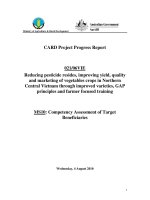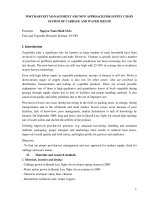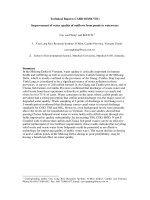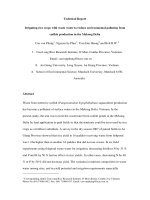Báo cáo khoa học nông nghiệp " Access of Vietnam’s Agro-Forestry Products to EU and US markets Status, Opportunities and Challenges " pptx
Bạn đang xem bản rút gọn của tài liệu. Xem và tải ngay bản đầy đủ của tài liệu tại đây (42.3 KB, 7 trang )
GAP Workshop in Binh Thuan (21-22/7/2008)
1
Access of Vietnam’s Agro-Forestry Products to EU and US markets
Status, Opportunities and Challenges
Ph.D. Cao Vinh Hai
Consulting Center for Environment Resources
And Rural Poverty Alleviation
I. Overview
Agro-Forestry products of Vietnam over the past 10 years have achieved positive
progress in exports, with average increase from 18 – 25%. Statistics of 2007 showed an
export turnover of US$8,650 m.
Some major export products are Wood furniture (US$2,350m), Rubber (US$1,425m)
Coffee (US$1,720m) and tea (US$129m. Agro products to the US reached US$600m
(Coffee, Rubber, cashew.). Since 2000 large increases in export value included coffee,
rubber and especially wood furniture with 11 times higher than that of the year 2000
(US$219m).
Wood furniture to US, in particular, accounted for over 50% of the total export turnover
of wood furniture exports. Fruit and vegetables to EU accounted for 25% and to China is
around 56%.
Above is the background for our study to focus on two main markets: US and EU.
Besides positive export figures, there are some outstanding issues that need to be
considered:
• Export turnover of fruit and vegetables increased from US$56.1m to US$305m
USD during 1995-2001 and from then on has been relatively constrant at
US$305-350m.
• Some Agro-forestry products have declined significantly, for example the “bee”
industry. In 2002, Vietnam ranked second in the word for export of honey. This
declined to number 6
th
and then 7
th
in 2007 with 14,000 tons of export volume
(value of around US$25m), a decrease of 2,000 to 3,000tons compared to the
previous years. Recently the EU temporarily stopped imports of honey from
Vietnam as the product failed to meet hygiene and food safety requirements.
Cashews have faced serious difficulties with the price of raw materials for cashew
increasing, poor processing facilities, lack of labour, high price of output
products, and low profit. Contracts undelivered from previous years have been
over 3000 containers (52,500 tons, May 2008).
• Main causes for slow growth or decline of some products are poor facilities,
warehouse storage and professional transport, and un-hygienic conditions.
• Even dragon fruit, the major export fruit of Binh Thuan, many export companies
have still do not fully understand the standards and requirements for hygiene and
safety as well as quarantine requirements. Management bodies have not yet been
equipped with facilities and man-power to manage this issue (in the whole region,
there’s only one Thanh Long Ham Minh Co-operative is granted with EU
standard certificate for one small area).
GAP Workshop in Binh Thuan (21-22/7/2008)
2
Is it right that Vietnam still lacks some Centers for Marketing and Trading of agro-
forestry products? Competitiveness of some export enterprises is still low?
Export of wood furniture has grown quickly but then faced with threats of being sued by
US companies for dumping (85% of wood material is imported for processing). Some
environmental organizations from Britain and Indonesia criticized some Vietnamese
enterprises for purchasing logs from illegal logging activities.
The above situation urges us to carefully evaluate the actual status of export of agro-
forestry products and clarify the opportunities and challenges. More attention should be
paid to special markets like EU and US in order to establish competitive solutions and
ensure sustainable export.
II. Outlines about EU and US markets
1. EU Market
This is a big market including 25 members (May 2004) with total population of
450 million and a GDP which is bigger than US or Japan. EU is the biggest
trading region in the world, accounting for nearly 50% of export and import
volume in the world, importing US$13.6b of fruit and vegetables in the year 2003.
The most typical features of this market are:
a. A diversified and difficult market, requiring many different way for access.
b. Fierce competition, thus goods need to have high quality and attractive packaging.
c. Attention is paid to health, safety and environment.
d. Goods, once entering one member’s market, will be circulated in the whole EU by
EURO currency.
e. To apply the GSP system (Generalized systems of Preferences) in order to support
export from developing countries or under-developed countries, an import tax rate
of 0% is applied to agro-forestry products. Wood furniture with an
Environmentally Friendly Certificate receives a reduction of 15-35% of import
tax rate.
f. Major fruit and vegetables imported by EU include: Banana, apple, grapes, and
fresh vegetables. These products are imported directly to Netherlands, France and
Belgium, then preserved and circulated to other EU countries through EU
distributors.
Calculation of import tax is based on reference prices: import price which is
higher or lower than that of reference will be considered for applying different tax
rates.
g. Additionally, EU applied CAP (Common Authentication Policy) for all fresh
products (quality, packing, and brand). If products meet all three criteria a CAP
certificate will be granted and the product is allowed to enter the EU.
h. Concerning hygiene and safety, it is required to comply with minimal chemical
residues (pesticide, veterinary medicine.) in order to enter the EU market.
i. Concerning SPS Agreement (Sanitary and Phytosanitary Measures Agreement):
main content of SPS is to set up basic rules to hygiene and safety of animals and
plants , to be tailored for each nation and agreed with SPS International under
WTO framework. This agreement took effective from 1/1/1995.
GAP Workshop in Binh Thuan (21-22/7/2008)
3
2. US Market
USA is huge market. Population is 288mil; GDP per capita is over US$36,000.
Annual import of Agro-forestry product reached over US$70b (2007), in which
fresh vegetables and fruits in 2003 was US$8.19b and wood furniture was
US$15b (2004). The US has a big potential for agro-forestry products from
Vietnam.
a. Features of US market
• A diversified and abundant market.
• Care about quality more than brand
• Need to well understand US laws, especially the Trade law of each state for the
business.
• Need to well understand about US-Vietnam bilateral Agreement.
b. US-Vietnam Bilateral Agreement
This Agreement was signed on 14
th
July 2000 and took effective from December
2001. The agreement consists of 4 issues:
• Services
• Goods
• Intellectual property
• Investment relations.
Through this Agreement, export products from Vietnam to this market will enjoy
MFN (Most Favoured Nation Treatment).
Tax imposed on Vietnamese goods will reduce from 40% to 0-5% (excluding
those are levied with anti-dumping tax rates).
Because of this Agreement, Vietnam has quickly increased exports to US and
received many new technologies (in 2007, US imports exceed exports byf over
US$8b).
c. Commercial policy
• Same as EU in applying GSP
• MFN
• Commercial policy on agro-forestry products based on “Agriculture adjustment”
which allows US to apply import quotas to agro-forestry products if they hurt the
internal programme and to control 12 essential agro products imported to US.
Major US imports from Vietnam include pepper, “da tron” fish, canned
cucumber, natural rubber, coffee, cashew.
d. Market channels and trading clues
US companies import agro-forestry products under three forms:
+ Buy raw materials (coffee, tea, pepper) then process, package and consume.
+ Act as intermediary to import processed food through large distribution groups.
+ Establish subsidiary companies in Vietnam and other countries, buy material,
process and then export to US.
e. Some ways to penetrate to agro-forestry market of US:
E1
: Organize channels, set up brands and trademarks to export with consumption
through some branches in US
GAP Workshop in Binh Thuan (21-22/7/2008)
4
Requirements: Companies should have reputation -> Need time to advertise and
market -> should understand US laws and regulations, otherwise will suffer
failure.
E2: Use names of US companies to process products, then pack in containers and
export to US.
E3: Deliver goods to specifically for Vietnamese American population (over 1
mil), then develop and serve for American and Asia-origin persons through
supermarkets of Vietnamese American. This is the most effective way.
III. Challenges and Opportunities for Vietnam’s agro-forestry products to
EU and US markets.
1. Opportunities:
a. Potentials for Vietnam’s agro-forestry to EU and US are high, even for wood
furniture.
b. European and US companies are moving to Vietnam to invest after Vietnam
entries WTO because Vietnamese market is considered to have stable political
environment with high growth rate. In the near future, US may become the
number one investor in Vietnam.
c. Vietnam’s agro-forestry products have a high portion of tropical products
(peppers, coffee, and dragon food) and will therefore establish a high position in
temperate countries. They account for 0.2% of EU’s import market share and
0.5% of US.
d. Vietnam has an abundant labour force to produce agro-forestry products, with a
low labour cost.
e. Export enterprises of Vietnam have gained much experience from successes and
failures in export during the last years. Many specialized and scientific bodies in
Institutes, Universities have made big efforts to help enterprises in creating
valuable seedlings and varieties. For example, pepper productivity of some
households in Vietnam is the highest in the world (15 tons per ha).
Preservation, processing and packaging of agro-forestry products have made
progress with higher quality, helping enterprises to compete in regional and
international markets.
f. The Vietnamese Government will have special prioritized investment policy for
agro-forestry sector to ensure these products increase in both quality and quantity
aspects.
2. Challenges
a. Vietnamese agro-forestry products are not well diversified and quality is still low.
Many Vietnamese companies compete amongst themselves to sell and buy, and
competitiveness is low. Vietnam’s fruit and vegetables like tomato, pineapple,
banana, have lower productivity and high prices. Some fruits like longan and
durian have lower quality than those from Thailand.
b. The production regions for agro-forestry products are not concentrated. Many
materials and additives for processing are imported. Quality of seedlings and
varieties are not uniform of as high as other countries.
GAP Workshop in Binh Thuan (21-22/7/2008)
5
c. Establishment of ISOs, brand, trademarks and packaging has been slowly and
unevenly implemented. Advertisements to access the market have been restricted.
Lack of market forecasts has caused losses from exports (cashew).
d. Post-harvest technology: Preservation and processing of agro-forestry products
are not well advanced. Factory location is often where raw material is short and
vice versa. Lack of specialized transport vehicles concern farmers because mature
fruits are not be able to be transported to the buyers. Losses through decayed
products after harvest have accounted for over 20%.
e. Hygiene and safety for food, fruits and vegetables have not been ensured,
particularly contents of SPS and MRLS are not fully complied with by the export
enterprises.
EU refused to import Vietnamese honey for many reasons: false products,
beekeeper mixed honey with sugar, medicine residue over the allowed level. This
is a lesson which needs to learned by the whole agro-forestry export sector.
f. Organization of distribution and export: the value chain of the products has been
blocked somewhere. Agro-forestry export enterprises have not worked closely
with farmers in production planting zones.
Linkage from seedlings, input of services, production, and agro-forestry extension
are not close and consistent. Network of harvesting, preservation, transport,
keeping in the warehouse have not been smoothly run.
Market approach and marketing are scattered which hinders the potential of the
market.
IV. Solutions and Recommendations
With these above opportunities and challenges, we would like to propose some
solutions and recommendations as follows:
1. Negotiation with US
The Government should negotiate early with the US to reach the following
agreements:
a) US should early recognize Vietnam as a market economy in order for
Vietnamese goods to be equally treated under US laws.
b) US should apply GSP (generalized systems of preferences) to Vietnamese
goods.
c) Bilateral co-operation between customs of US and Vietnam will help
Vietnam’s customs to clear import and export goods to US early and enable
easy penetration of Vietnam’s goods to other markets.
d) Two countries should early sign the Bilateral Investment Treatment to help
US to become the first investor in Vietnam.
2. Establishment of regulations to fight against permanent barriers to EU and US
These regulations include:
a) Technical standards for exporting goods (quality, brand, packaging).
b) Food hygiene and safety through applying SPS Treatment and Residue
Control (MRLs).
c) Through SPS and MRLs, “export control” (compulsory and voluntarily)
should be applied to ensure quality and prestige of Vietnamese goods.
GAP Workshop in Binh Thuan (21-22/7/2008)
6
d) Establishment of solutions to respond to anti-dumping cases and subsidy
(diversifying market, master the commercial laws, be careful with customers).
3. Set up sustainable relations among producers, processors and exporters).
a) Through the value chain, to create linkages to share profits between farmers
and exporters with support from scientists and Institutes.
4. Develop specialized and interposed material zones
a) Depending on agro-forestry items to focus on investment and establishment of
specialized and interposed material zones, from studying to get good
seedlings, materials and production process in order to have agro-forestry
products matching the quality and productivity of other countries like
Thailand, China, Singapore (scale of material zones should be at small and
medium size).
5. Enhance competitiveness of agro-forestry export enterprises
a) Agro-forestry export enterprises should quickly enhance competitiveness of
leading experts, engineers and technical workers in order to produce high-
quality products. They should understand the commercial laws and
commitment of Vietnam about taxes after joining WTO.
b) Should understand Agreements, GPS, CAP, MRLs, MFN., Functional bodies
and international organizations, NGOs should help them to understand these
papers through training, seminars and workshops.
c) Enterprises should establish brand, ISO, open website, and use commercial
trade.etc.
d) Associations and sectors should co-operate with VCCI to open trading center,
exhibitions, auction of agro-forestry products. VCCI should care for
enterprises in all three regions of the country to approach international
markets.
e) It is necessary to early assign and complement commercial representatives of
the sector to support enterprises in major export markets.
f) Market forecast and information about product categories, quality and prices
should be considered as the pioneer in export in order to get sustainable
growth.
Conclusion
Agro-forestry products of Vietnam are diversified,plentiful and tropical. So far,
Vietnam has been a country with good food security and stable political
conditions. Nature has endeared Vietnam regions for developing material for
agro-forestry products.
Agro-forestry export products of Vietnam have accounted for only 20-30% those
produced domestically. Besides, we have around 12 mil ha forest but exploration
of forest specialities has been low.
It is hoped that once we clearly recognize opportunities and challenges and well
understand features of each market and competitors, we will have right solutions.
Agro-forestry export will position firmly in international market.
GAP Workshop in Binh Thuan (21-22/7/2008)
7
Reference
1. Doing business with EU Market and US market - Status, Challenge and
Opportunities.
(Dr. Cao Vinh Hai, Training material for enterprises in two regions, 2005)
2. Export market for fruit and vegetables.
(Asso.Prof.Dr Nguyen Van Nam, Commercial Research Institute, Thong
Ke Publishing House, 2005)
3. Fruits and Vegetables Sector in Vietnam
(Institute for researching international food policy, GTZ, 2002)
4. Vietnam Economics News
(Weekly magazines, 2008)
5. Sanitary and Phytosanitary Measures Agreement).









